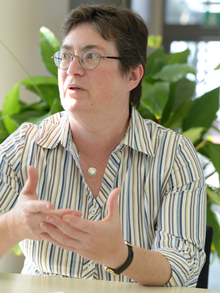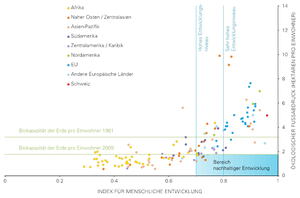Archive detail
Janet Hering elected for third term as Eawag Director
August 20, 2014 |
Interview with Prof Janet Hering: Switzerland: a leading example of sustainable water management.
Switzerland’s drinking water is safe and of high quality. This is the result of an effective water protection regime. According to Eawag Director Janet Hering, the country has the resources which are required to support sustainable water management. At the same time, there is a need to resolve conflicts arising from competing water uses and to set the right priorities. Interview: Andres Jordi
With countless micropollutants in rivers and streams, a changing climate, extreme flooding and river restoration projects, the quality of our drinking water sourced from river-fed groundwater seems to face challenges on many different fronts – as suggested by various contributions to this year’s Info Day. And yet you argue for a sense of proportion. What are the grounds for your optimism?
For optimists, the glass is half full, while for pessimists it’s half empty. Our job as scientists is to ask relevant questions about the glass and its contents – in this case, water deriving from bank filtration. Here, it’s important to understand the biogeochemical processes involved, what factors affect this system and how they will influence it in the future. But this scientific understanding, in itself, still doesn’t tell us how urgently particular issues should be addressed. Switzerland’s springs and groundwater generally provide high-quality drinking water, which does not require further treatment. In this respect, our water supply compares very well with those of many other industrialized countries ...
... so we can sit back and relax?
No, I’m afraid not! Although the situation in this country is very good, there are some areas where action is required. That’s been demonstrated by various Eawag studies presented at our Info Day. But I think we shouldn’t forget that – in terms of the quality, safety and availability of our water supply – Switzerland is a global leader. In the past, this country has shown time and again that it takes water protection seriously. Just think of the efforts to combat the eutrophication of lakes, such as Lake Zurich. And the recently launched programme of wastewater treatment plant upgrades – to reduce discharges of micropollutants – represents another milestone in the country’s water protection efforts. I think this makes it all the more important to avoid any schemes that would jeopardize this progress: from a water research perspective, the federal authorities should resist calls to increase inputs of phosphorus to lakes in the hope of rising fish yields.
As regards water supply, what challenges does Switzerland face?
Though Switzerland is of course well placed as Europe’s “water tower”, resources are not unlimited, even in this country. So it’s essential to manage these resources as sustainably as possible. Sustainable water management depends not only on natural conditions, such as water availability (precipitation, natural storage and conveyance), but also on technical and social factors. There may be multiple, often conflicting, water uses – for example, if a river reach is to be restored close to a groundwater well. In such cases, a “win-win” is not always possible. There is a need to set the right priorities in the interests of environmental, social and economic sustainability (the triple bottom line). So a sound scientific basis is required for decision-making.
What strengths can Switzerland call on in pursuing sustainable water management?
Switzerland is in a relatively comfortable position. The country’s GDP per capita is among the highest worldwide, it’s a global leader on the UN Human Development Index (HDI), it has substantial water resources and a fairly good environmental scorecard. Its industry is highly productive and innovative. And another important asset, it seems to me, is the consensus-oriented political culture. This means that Switzerland has the technical, financial and social resources needed to support sustainable water management.
So is Switzerland a model for sustainability?
Other industrialized countries could certainly follow Switzerland’s example in the pursuit of sustainability. If you look at the ratio of HDI to Ecological Footprint, Switzerland fares better than a number of comparable countries (see Figure). In other words, even with a very high level of development, it’s possible to manage natural resources sustainably – although it can be seen that Switzerland has yet to reach the defined “sustainable development goal”. Switzerland’s innovative strength could also encourage other countries to develop and apply cleantech solutions. Equally, there are opportunities for Switzerland to export technologies and know-how in this sector.
Would that be restricted to industrialized countries?
Developing and emerging countries can also benefit from the transfer of technologies and knowledge. At the same time, there’s a need for capacity development to enable these countries to pursue sustainable development themselves. Here, too, Switzerland has a lot to offer.
What can the various sciences contribute to sustainable water management?Well, I’ve already mentioned research on processes and systems – understanding these is essential for an appropriate management strategy. In addition, engineers develop new technical processes that can be adopted in practice. Social scientific methods help to make decision-making processes more transparent and to evaluate possible options, so as to identify solutions acceptable to the stakeholders concerned.
The UN Human Development Index (HDI) compared with the Ecological Footprint for various countries. The HDI describes the level of human welfare in various regions of the world. The Ecological Footprint indicates the area of land and water required per capita to support a country’s standard of living under present conditions. Biocapacity, in turn, measures the ability of an ecosystem to produce useful biological materials. (Source: Global Footprint Network)


